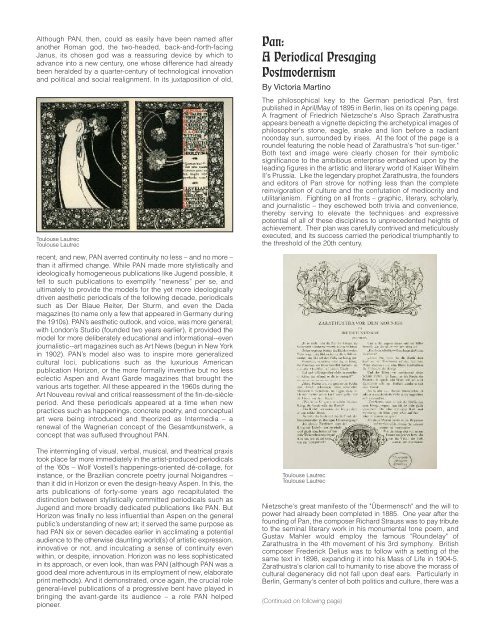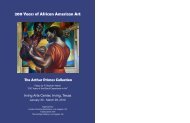PAN PAN - Landau Traveling Exhibitions
PAN PAN - Landau Traveling Exhibitions
PAN PAN - Landau Traveling Exhibitions
- No tags were found...
Create successful ePaper yourself
Turn your PDF publications into a flip-book with our unique Google optimized e-Paper software.
Although <strong>PAN</strong>, then, could as easily have been named after<br />
another Roman god, the two-headed, back-and-forth-facing<br />
Janus, its chosen god was a reassuring device by which to<br />
advance into a new century, one whose difference had already<br />
been heralded by a quarter-century of technological innovation<br />
and political and social realignment. In its juxtaposition of old,<br />
Toulouse Lautrec<br />
Toulouse Lautrec<br />
recent, and new, <strong>PAN</strong> averred continuity no less – and no more –<br />
than it affirmed change. While <strong>PAN</strong> made more stylistically and<br />
ideologically homogeneous publications like Jugend possible, it<br />
fell to such publications to exemplify “newness” per se, and<br />
ultimately to provide the models for the yet more ideologically<br />
driven aesthetic periodicals of the following decade, periodicals<br />
such as Der Blaue Reiter, Der Sturm, and even the Dada<br />
magazines (to name only a few that appeared in Germany during<br />
the 1910s). <strong>PAN</strong>’s aesthetic outlook, and voice, was more general;<br />
with London’s Studio (founded two years earlier), it provided the<br />
model for more deliberately educational and informational--even<br />
journalistic--art magazines such as Art News (begun in New York<br />
in 1902). <strong>PAN</strong>’s model also was to inspire more generalized<br />
cultural loci, publications such as the luxurious American<br />
publication Horizon, or the more formally inventive but no less<br />
eclectic Aspen and Avant Garde magazines that brought the<br />
various arts together. All these appeared in the 1960s during the<br />
Art Nouveau revival and critical reassessment of the fin-de-siècle<br />
period. And these periodicals appeared at a time when new<br />
practices such as happenings, concrete poetry, and conceptual<br />
art were being introduced and theorized as Intermedia – a<br />
renewal of the Wagnerian concept of the Gesamtkunstwerk, a<br />
concept that was suffused throughout <strong>PAN</strong>.<br />
The intermingling of visual, verbal, musical, and theatrical praxis<br />
took place far more immediately in the artist-produced periodicals<br />
of the ‘60s – Wolf Vostell’s happenings-oriented dé-collage, for<br />
instance, or the Brazilian concrete poetry journal Noigandres –<br />
than it did in Horizon or even the design-heavy Aspen. In this, the<br />
arts publications of forty-some years ago recapitulated the<br />
distinction between stylistically committed periodicals such as<br />
Jugend and more broadly dedicated publications like <strong>PAN</strong>. But<br />
Horizon was finally no less influential than Aspen on the general<br />
public’s understanding of new art; it served the same purpose as<br />
had <strong>PAN</strong> six or seven decades earlier in acclimating a potential<br />
audience to the otherwise daunting world(s) of artistic expression,<br />
innovative or not, and inculcating a sense of continuity even<br />
within, or despite, innovation. Horizon was no less sophisticated<br />
in its approach, or even look, than was <strong>PAN</strong> (although <strong>PAN</strong> was a<br />
good deal more adventurous in its employment of new, elaborate<br />
print methods). And it demonstrated, once again, the crucial role<br />
general-level publications of a progressive bent have played in<br />
bringing the avant-garde its audience – a role <strong>PAN</strong> helped<br />
pioneer.<br />
Pan:<br />
A Periodical Presaging<br />
Postmodernism<br />
By Victoria Martino<br />
The philosophical key to the German periodical Pan, first<br />
published in April/May of 1895 in Berlin, lies on its opening page.<br />
A fragment of Friedrich Nietzsche's Also Sprach Zarathustra<br />
appears beneath a vignette depicting the archetypical images of<br />
philosopher's stone, eagle, snake and lion before a radiant<br />
noonday sun, surrounded by irises. At the foot of the page is a<br />
roundel featuring the noble head of Zarathustra's "hot sun-tiger."<br />
Both text and image were clearly chosen for their symbolic<br />
significance to the ambitious enterprise embarked upon by the<br />
leading figures in the artistic and literary world of Kaiser Wilhelm<br />
II's Prussia. Like the legendary prophet Zarathustra, the founders<br />
and editors of Pan strove for nothing less than the complete<br />
reinvigoration of culture and the confutation of mediocrity and<br />
utilitarianism. Fighting on all fronts – graphic, literary, scholarly,<br />
and journalistic – they eschewed both trivia and convenience,<br />
thereby serving to elevate the techniques and expressive<br />
potential of all of these disciplines to unprecedented heights of<br />
achievement. Their plan was carefully contrived and meticulously<br />
executed, and its success carried the periodical triumphantly to<br />
the threshold of the 20th century.<br />
Toulouse Lautrec<br />
Toulouse Lautrec<br />
Nietzsche's great manifesto of the "Übermensch" and the will to<br />
power had already been completed in 1885. One year after the<br />
founding of Pan, the composer Richard Strauss was to pay tribute<br />
to the seminal literary work in his monumental tone poem, and<br />
Gustav Mahler would employ the famous "Roundelay" of<br />
Zarathustra in the 4th movement of his 3rd symphony. British<br />
composer Frederick Delius was to follow with a setting of the<br />
same text in 1898, expanding it into his Mass of Life in 1904-5.<br />
Zarathustra's clarion call to humanity to rise above the morass of<br />
cultural degeneracy did not fall upon deaf ears. Particularly in<br />
Berlin, Germany's center of both politics and culture, there was a<br />
(Continued on following page)




